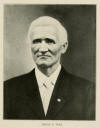BIOGRAPHY - ISAAC DAY
 Isaac
C. Day, who owns and operates a valuable farm of one hundred and sixty acres
on section 30, Lyman township, was born in Belmont county, Ohio, on the 18th
of September, 1843, his parents being John and Ann (Crew) Day, the former a
native of Pennsylvania and the latter of North Carolina. John Day removed to
Ohio with his parents when but a small boy and when he had reached man's
estate built a log house with clapboard roof and puncheon floor and a stick
chimney, living in this primitive structure for twenty years. He purchased
seventy-two acres of land, which he cleared of the heavy timber, thus making
a nice farm and planting the seeds of civilization in a hitherto wild and
uncultivated district. He also followed his trade of shoemaking in
connection with his farming interests, and in politics was a stanch whig and
later a republican, taking an active part in the local affairs of his party
and giving loyal support to every movement or measure which he deemed would
prove beneficial to the general public. His demise occurred in 1884 and the
mother of our subject died in 1863, both passing away in Ohio. In the family
were nine children, of whom six are now deceased. Stephen, who makes his
home in Ohio, is the only survivor of his father's first marriage, and there
are three by the second: Isaac C., of this review; James H.; and Anna, wife
of Lon Hobbs, both residents of Barnesville, Ohio.
Isaac
C. Day, who owns and operates a valuable farm of one hundred and sixty acres
on section 30, Lyman township, was born in Belmont county, Ohio, on the 18th
of September, 1843, his parents being John and Ann (Crew) Day, the former a
native of Pennsylvania and the latter of North Carolina. John Day removed to
Ohio with his parents when but a small boy and when he had reached man's
estate built a log house with clapboard roof and puncheon floor and a stick
chimney, living in this primitive structure for twenty years. He purchased
seventy-two acres of land, which he cleared of the heavy timber, thus making
a nice farm and planting the seeds of civilization in a hitherto wild and
uncultivated district. He also followed his trade of shoemaking in
connection with his farming interests, and in politics was a stanch whig and
later a republican, taking an active part in the local affairs of his party
and giving loyal support to every movement or measure which he deemed would
prove beneficial to the general public. His demise occurred in 1884 and the
mother of our subject died in 1863, both passing away in Ohio. In the family
were nine children, of whom six are now deceased. Stephen, who makes his
home in Ohio, is the only survivor of his father's first marriage, and there
are three by the second: Isaac C., of this review; James H.; and Anna, wife
of Lon Hobbs, both residents of Barnesville, Ohio.
Isaac C. Day pursued his education in the common schools, remaining with his father until he attained the age of twenty-one years, when he enlisted for service in the Civil war as a member of Company E, Seventy-seventh Ohio Infantry, being mustered out at Brownsville, Texas, in the spring of 1865. He returned home at the close of the war with a creditable military record and then began earning his own living, being employed as a farm hand for two years. In the fall of 1866 he came to Illinois, locating first in Marshall county, where he also worked as a farm hand for two years. On the expiration of that period he came to Ford county, and after he had been engaged at farm labor here for a year he was married and rented a farm, which he successfully operated for eighteen years. He then purchased one hundred and sixty acres of land on section 30, Lyman township, where he still resides, having brought his fields under a high state of cultivation and development. In addition to the work of general farming he also fed and shipped stock for several years, both branches of his business bringing to him a gratifying financial return annually. The success which he now enjoys is entirely the result of his own well directed labor and enterprise and he is accounted one of the substantial and progressive citizens of the community.
Mr. Day was united in marriage to Miss Sarah Thompson, who was born in Ohio in 1845, of which state her mother was also a native, while her father was born in Virginia. Mrs. Day was one of a family of seven children and by her marriage has become the mother of four children: William, of Lyman township; H. A., at home; Anna, the wife of Andrew Arends; and Stanley, also at home.
In his political views Mr. Day is a republican and is quite prominent in the local ranks of his party, having served as school director for six years and as constable for three years. He is a member of the Grand Army post, No. 500, at Melvin, while his religious faith is indicated by his membership in the Methodist Episcopal church, to which his wife also belongs. He has been identified with the agricultural interests of Ford county from a very early day and has not only been a witness but also an active participant in the arduous labor which transformed this region from a wild and windswept prairie into one of the richest farming districts of the great state of Illinois. He is widely and favorably known throughout the entire community and has won the warm esteem and confidence of all with whom he has come in contact.
Extracted 17 Oct 2016 by Norma Hass from History of Ford County, Illinois, From Its Earliest Settlement to 1908, author E. A. Gardner, Volume 2, pages 700-704.



